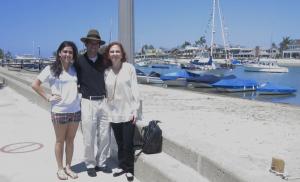When I started posting, I told our publisher, Joel Fox, that I’d only write on the dynamics of jobs in California. But I think he’ll indulge me on the post below about a segment of California past-and hopefully future.
Donna and I were at UC Irvine recently, and took the opportunity with our oldest daughter Sonia to drive to Balboa Island.
From the university to the Island is a short drive straight down Jamboree. The hilltops above Jamboree are filled with oversized condos and apartment complexes. But as you cross the Pacific Coast Highway, the road narrows to a two lane bridge, the condos and apartments disappear, and you find yourself on Marine street, the main street for Balboa Island.
Jamboree road was built in the early 1950s (part of the Boy Scouts National Jamboree of 1953, held in the area), and I remember it from this period. From 1957 to 1970, my family drove from Los Angeles to Balboa each summer for a week in June and a week in September. We rented one of the small summer cottages that dotted the island-usually on Garnet Street or Pearl Street.
I had come to Balboa only once since 1970, but I need not have worried. In contrast to the overbuilding that has undermined much of Newport Beach, Balboa Island hasn’t changed. Some of the cottages have been rebuilt or modernized But the clean sand, calm waters, small piers and boats remain little changed from the 1950s, as you can see in the photo below.

We walked around the Island, and then took the car/passenger ferry to the Balboa Peninsula (the ferry has been running since 1919). The "Fun Zone" arcades are still in operation, and seem to have the same low-tech/no-tech arcade games as fifty years ago-just as the nearby amusement park hums along with its same Ferris wheel and merry-go-round. The food stands sell the high-calorie ice creams, frozen bananas and corn dogs, but in their midst has grown upscale a number of more health-conscious restaurants and cafes.
As we dropped off Sonia back on campus, and returned to the airport, we discussed the contrast between the Island and the overbuilding in much of Newport Beach and Irvine. The Island was easier to preserve than most California communities of the period, since it already was built out by the 1950s, and had no land for additional housing tracts. Yet, its qualities-a walkable, small scale, mixed-use community in which residents are highly involved in community affairs-are as relevant and appropriate today as fifty years ago.
Far from being the past, Balboa Island continues to offer lessons for hundreds of communities in California today.

